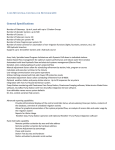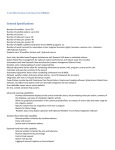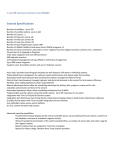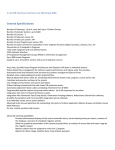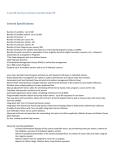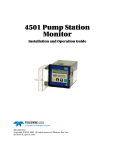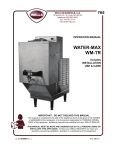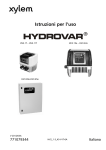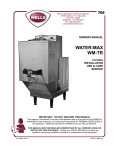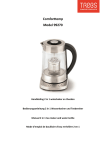Download Crown Boiler WWD224W-2 Specifications
Transcript
WaterMax SUPER SPORTS TURF PUMP STATION Variable Frequency Drive Control System GENERAL SPECIFICATIONS Project Name: ? Project Location: ? Pumping System Model #: WaterMax SSTV-HP-Voltage-Phase-Flow-Boost Total Design Criteria: Quantity of Pumps: ? Station Design Capacity: ? GPM @ ? PSI Discharge 08/22/06 SCOPE OF WORK It is the intention of this specification to describe an automatic, prefabricated, self-enclosed, pump station for irrigation purposes. Design, fabrication, testing and service shall be the sole responsibility of the pump station manufacturer. The pump station shall provide water to the irrigation system while simultaneously maintaining a constant discharge pressure by using a prefabricated pump station with variable frequency drive (VFD) pumps for pressure regulation, under varying flow conditions up to the maximum specified capacity. Construction shall include a fabricated steel plate and skid assembly to support all components during shipping and to serve as the installed mounting base. SECTION 1: GENERAL 1.1 The prefabricated pumping station shall have a minimum capacity and discharge pressure at skid edge as stated in the technical specifications. 1.2 The station shall be completely wired, piped, hydraulically and electrically tested prior shipment. 1.3 The discharge manifold from the pump station shall terminate at or near the pump station skid edge and be provided by the pump station manufacturer. The pumping station shall be model number WaterMax SST as manufactured by WATERTRONICS, INC. 525 Industrial Drive, P.O. Box 530, Hartland, Wisconsin 53029-0530, www.watertronics.com. SECTION 2: MANUFACTURER REQUIREMENTS 2.1 MANUFACTURER The pump station shall be manufactured by Watertronics Inc., Hartland, Wisconsin. The following information must be furnished by the contractor or manufacturers representative: a. A complete specification and submittal of all major components for the proposed pump station with individual pump performance verification. b. A detailed pump station proposal drawing complete with component location, sizes and dimensions specific to the installation. c. A complete electrical schematic for all high and low voltage circuits showing breaker/fuse sizing, wire numbering and color. d. Pump station manufacturers U.L. file number for the entire pump station. e. A copy of the manufacturers certificate of insurance. 1 SECTION 3: PUMPS AND MOTORS 3.1 PUMPS Pumps shall be electric motor driven, horizontal centrifugal with mechanical shaft seal, volute case and impeller. The shaft seal shall be a self-adjusting mechanical type to prevent leakage and eliminate the need for drain piping. The volute case shall be precision machined from gray cast iron and engineered to modern hydraulic standards. It shall be possible to rotate the discharge connection to any of four positions. A heavy cast iron bracket shall maintain alignment between the motor and volute cast. The impeller shall be an enclosed type and balanced to provide smooth operation. The impeller is to be keyed to the shaft and locked with a special cap screw and washer. The motor shaft is to be manufactured from high grade steel and of reduced length to increase shaft rigidity, extend bearing life, and reduce the overall length of the pump and motor assembly. The motor shaft shall be protected with a replaceable stainless steel sleeve. 3.2 MOTORS Each pump motor shall be a squirrel cage induction horizontal solid shaft type. The pump impeller shall be direct mounted and keyed to the motor shaft with a stainless steel protective sleeve. The temperature rise of the motor shall be to NEMA Standard MG-1- Class F insulation. Radial and thrust bearings of ample capacity to accommodate the hydraulic thrust of the pump shall be incorporated into the motor. The motor shall be of proper size to drive the pump at any point on it's operation curve without exceeding the service factor nameplate rating. SECTION 4: SKID, PIPING, VALVES, GAUGES, MECHANICAL EQUIPMENT 4.1 SKID CONSTRUCTION Pump station skid shall be formed from a single sheet of steel. Continuous welded and smooth ground at all corners resulting in a seamless, one piece structure with rounded edges and corners. If required, the skid shall be strategically reinforced underneath with structural channel iron to support pumps, manifold control enclosure and periphery. Flat steel, diamond or checker plate welded over structural steel shall not be permitted. The skid shall be drilled and tapped for mounting of pumps, manifolds, relief valves and other equipment. All tolerances shall permit direct bolting of pump station components to skid. The exterior of the skid will have drilled holes for anchor bolts. There will be two holes at each corner for lifting. The skid shall be primed and painted per enclosed specifications on both top and bottom. 4.2 FABRICATED PIPING All fabricated piping shall conform to ASTM specifications A53 for Grade B welded or seamless pipe. Discharge piping 6" and smaller shall be Schedule 40. All welding flanges shall be forged steel slip-on or welding neck type. All welding fittings shall be seamless, conforming to ASTM Specification A234, with pressure rating not less than 150 PSI. 4.3 DRAIN VALVES Drains are to be provided from any possible low point in the system and are to consist of 1/4" brass petcocks. They include, but are not limited to, the following: - Drain for each pump discharge check valve - Drain in discharge manifold 2 4.4 A wash-down 3/4" brass hose bib shall be provided downstream of the control valves, upstream of the main station isolation valve PUMP CHECK VALVES Pump check valve shall be of the silent operating type that begin to close as forward velocity diminishes and be fully closed at zero velocity preventing flow reversal. Valve bodies shall be cast from ASTM-126C cast-iron or better and shall be free from blow holes, sand holes, and other impurities. The valve design shall incorporate a center guided, spring loaded poppet, guided at opposite ends and having a short linear stroke that generates a flow area equal to the pipe diameter. Internals shall be machined bronze disc, seat, and stem guide. Valves shall be sized to permit full pump capacity to discharge through them without exceeding a pressure drop of 2.5 PSI. Valves 4” and smaller to be pressure rated for 250 PSI, and 6” to be pressure rated to 150 PSI. 4.5 ISOLATION VALVES Isolation valves shall be butterfly type with ten position lever for sizes 4" and smaller and gear operators for sizes above 4". All shall be rated at 200 PSI WOG working pressure. Trim shall include stainless steel stem, bronze or nickel coated iron streamlined disc, and full faced resilient seat designed to eliminate need for flange gaskets. 4.6 PRESSURE GAUGES A pressure gauge shall be located on the discharge manifold for the purpose of measuring regulated, downstream pressure. Pressure gauge shall be 304 stainless steel case and bezel construction. Gauge shall be 2-1/2" diameter, liquid filled. Pressure sensing connection shall be 1/4" NPT lower gauge connection. SECTION 5: U.L. LISTED CONTROL PANEL, LOGIC AND SENSORS 5.1 GENERAL The pumping station electrical controls shall be mounted in a self-containing NEMA 3R enclosure fabricated from not less than 12 gauge steel. Door gasket seals shall be neoprene sponge, sufficient to protect interior components from weather and dust. The electrical panel door(s) shall be constructed from 12 gauge steel with integral latches. All external operating devices shall be dust and weather proof. All internal components of the enclosure shall be mounted on a removable back panel. Mounting screws for components shall not be tapped into the enclosure wall. All internal wiring within, and interconnecting between, the panels shall be complete and no field wiring within the panels shall be required. Wiring troughs and cable raceways shall be self-contained within the enclosure and no external cable trays or wiring roughs are permitted. No pressure gauges, pressure switches, water activated devices, or water lines of any sort shall be installed in any electrical control panel. The control panel shall be designed, built, tested and U.L. listed by the pump station manufacture. The pump station discharge pressure shall be regulated to provide surge-free constant pressure as programmed via the control panel operator interface. The control system will have the following features: a. Gradual entry of water from the pump into the discharge manifold to allow for complete purging of air to eliminate pressure surging. b. c. Maintain programmed downstream pressure regardless of discharge flow. Up to six, user adjustable PID control settings to ensure accurate pressure regulation at all flows, programmed pressure, or connected pump combination. 3 d. Adjustable pressure ramp-up and ramp-down to assure surge free pressure regulation. e. After a drop in pressure, gradually increase system pressure over a user adjustable period of time to eliminate surging. f. Rate of change of pressure control to anticipate and eliminate rapid pressure changes caused by changing system demand. Discharge pressure regulation shall be by a Variable Frequency Drive. Adjustment of regulated downstream pressure shall be accomplished though the control panel operator interface. Hydraulic type, pilot controlled pressure reducing valves shall not be accepted. 5.2 VARIABLE FREQUENCY DRIVE (VFD) The variable frequency drive shall be IGBT based with selectable carrier frequency up to 15 KHZ. The VFD shall include terminals for incoming power, motor output power and control terminals. The VFD shall generate a sine-coded, variable voltage/ frequency, three phase output for optimum speed control. The VFD shall incorporate power loss ride-through for a minimum of 2 seconds. VFD protective features shall include current limit, auto restart, short circuit protection, electronic motor overload protection and ground fault protection. The VFD shall have a push button programming display for easy access to operation parameters. The VFD shall be protected on the primary side by fuses of the appropriate amperage. Overload capacity: 120% rated output current for one minute. Voltage Fluctuation: +10%, -15%. Sine wave PWM with full range, automatic torque boost. Frequency Control Range: 0.1 to 400Hz. Frequency Accuracy: Digital, 0.01Hz, Analog. .1%. Motor overload protection, Instantaneous Over current of 180% of rated output current. Over voltage at 820VDC if 460V input. Under voltage: user adjustable. Momentary Power Loss: up to 2 second ride through. Electronic Ground Fault. LED capacitor charge indicator. Input Phase loss alarm. Ambient temperature range of + 14 to 104 degrees F. Humidity of 95% non-condensing. 5.3 MAIN SERVICE DISCONNECT A three-pole, main service rated disconnect shall be contained within the NEMA 4 control enclosure. An externally mounted service disconnect shall not be acceptable. Disconnect shall isolate all power to the control enclosure. The disconnect shall have an operating handle mounted in the enclosure door, mechanically interlocked to prevent entry while disconnect is in the ON position. 5.4 MOTOR FUSES, STARTERS AND OVERLOADS Each started shall be protected on each leg by a time delay fuse of the appropriate amperage. Motor starter coils shall be 120 volt operated. Overload relays shall be electronic type, ambient compensating and differential tripping type. Bi-metallic or melting alloy type overloads shall not be permitted. The overload shall protect each power leg and shall be set to the motor's full-load current rating. Further protection shall include sensitivity to current imbalance and single phase conditions. 5.5 CONTROL TRANSFORMER A control transformer shall provide 120 volt power to the pump station controls. The control transformer shall be protected on the primary and secondary sides with appropriately sized fuses. No load other than the pump station controls shall be supplied by the control transformer. 5.6 CONTROL LOGIC The pump sequence controller shall be an industrial grade PLC with diagnostic LED's for monitoring of discrete inputs and outputs. Not less than two additional analog inputs and outputs shall be standard for 4 monitoring and control purposes. The PLC shall contain two communication ports for monitoring and programming purposes. The PLC shall contain an EEPROM, battery backed RAM and non-volatile memory for storage of critical configuration data. 5.7 ALARMS Controls shall shut down the pump station in the event of the following alarm conditions. The controls shall attempt to restart the system after alarm shutdown or loss of power to minimize loss of irrigation. After a user adjustable number of attempts to re-pressurize the system, the controls will go into hard shut down and remain there until manually reset. 5.8 1. Low discharge pressure cutout. Pressure remains 20 PSI below regulated set point for a set time delay. 2. High discharge pressure cutout. Pressure remains 11 PSI above regulated set point for set time delay. 3. Phase / voltage cutout; High or low voltage; loss of phase or phase reversal. 4. High pump volute temperature cutout. Pump temperature stays above 120 degrees F. for a set time delay. 5. Starter fail cutout. Output to starter is not met with corresponding running input for set time delay. Indicates overload, phase imbalance or control fuse. Operator Interface Operator interface shall be a full color TFT active matrix LCD display unit mounted in the enclosure door. Operator interface shall be used for logical display of all pump station functions. The operator interface shall be NEMA 4 rated. The operator interface shall be touch sensitive with intuitive on-screen user instruction for ease of operator use. The use of buttons or keys or off-screen user instructions shall not be permitted. The operator interface shall be LCD color display type with no less than 240 x 320 pixel resolution, with viewing area measuring not less than 5.7" diagonal. User memory for storing critical pump operation data shall not be less than required for up to 1 year of data. The operator interface shall allow the user to view and modify all pertinent operation parameters. The operator interface shall incorporate password protection for modification of critical pump station parameters. The operator interface capabilities shall include but are not limited to the following: a Overview screen showing pump system configuration. Screen shall show if each individual pump is enable or disabled, the number of hours on each pump, station full flow and pressure design criteria b. System screen with information on current regulation pressure, setpoint, regulation pressure, System status, restarts remaining, VFD reference speed, pressure regulation method (VFD or EBV modes) and adjust settings button. Adjust settings button will allow changing parameters etc after entering password. c. Settings menu to allow changes to pressure regulation settings, pipe saver mode, VFD manual mode, analog calibration, flow calibration, program or register settings. d. Flow screen will display pressure in PSI, flow in GPM and total gallons pumped in thousands of gallons. Separate display for total gallons pumped since last reset. 5 5.9 e. Alarm status with time stamping, display of pump station conditions at shutdown and restart. Alarms will be displayed in red when activated and a separate listing will be displayed in green when the alarm is reset. Alarms will be logged to a compact flash disk allowing the service technician to upload data to a spreadsheet type program. f. Full control of and capability of monitoring, adjusting and viewing any options present such as water level, inlet strainer, wye strainer, filtration, chemical injection, or liquid tank levels. Adjustment of automatic/manual pressure regulation set points. g. Graphing capability for up to 1 full year detailing flow rate and pressure. Graphing function shall give option to graph and plot a point every minute. The graph function will be selectable by day, month and year as well as the time of desired graph. All data will be logged to a compact flash disk allowing the service technician to upload data to a spreadsheet type program. WATERVISION REMOTE MONITORING SOFTWARE (OPTION: Must be called for in the Technical Specification Section) Pump station monitoring software (Watervision), will be fully compatible with Windows 95, 98, Me, 2000, and NT 4.0 for workstations. Software will include full graphical representation of the pump station and its features. The software will be capable of communicating at rates up to 19200 baud to the pump station over direct wire, dial-up telephone modem, cellular modem, radio modem, short haul modem, or over fiber cable. The software shall also be capable of communicating over the Internet and Intranets including dial-up networking to the computer connected to the pump station. One software package and installation procedure shall cover all above connection types. All connections and setting shall be field configurable. The remote monitoring software independent of connection type shall be capable of changing all operating parameters of the pump station. A single copy or multiple copies of the software can be loaded on a single computer to communicate to up to 256 different pump locations. A single site license will be supplied for each pump station location. A. The pump station manufacturer will supply all required communication hardware except; computer and computer accessories including phone modem, all necessary direct burial cable. The remote monitoring software shall require a PC based computer with minimum requirements: Pentium7 233MHz, 32MB RAM, 30MB of free hard drive space, VGA graphics card, one free serial port without IRQ sharing, mouse or trackball, 9600 baud phone modem if communications to the pump station require.(Above equipment by end user). B. The remote monitoring software shall feature full data sharing interaction between leading irrigation manufactures software using PumpLink. C. The software supplied by the pump station manufacturer will include all of the following features as standard, further customization to fit customer’s needs shall be available. Graphical overview of system operations including Pump Status, Flow, Pressures and Regulate Set Points Operational status of pumps; Enabled/Disabled, Running/Not Running, Position of Hand/Off/Auto switch Total number of hours of each pump’s operation since first activation Individual time of day lockout for each pump Display of maximum GPM designed for each pump Individual pump/motor alarm status such as overload relay trip due to excessive amperage draw and in HC stations, pump case temperature alarm View system Pressure and Flow in both digital and vertical bar graph form View of Final Regulate pressure set point and Current Regulate system pressure status in digital numbers View location for any current alarms with help screens for each. Alarms are: low pressure, high pressure, phase loss, low/high voltage, low water level, (if desired), individual motor overload with I.D., PLC low battery, VFD alarm, (if equipped), Pressurization Alarm, Final shutdown alarm Alarm reset button, with digital read out of re-starts remaining before final shutdown 6 System status: System O.K. or System Pressurizing Seven, (7) different pressure regulation points based on seven different user definable GPM flow brackets Set single pressure set point value. (Desired system pressure set point regardless of flow) Toggle between either Single Set Point or Flow Based Pressure Set Points Pump station’s historic total gallons pumped. Not user re-settable. Pump station’s total gallons pumped since last time user pushed reset button on either the Touchscreen operator interface or the monitoring software’s on screen mouse click button View and make individual adjustments for wet well inlet self-flushing filter, or discharge filter: 1. Duration of flush. 2. Frequency of flush. 3. Flush enabled or disabled. 4. Differential PSI. 5. Manual Flush 6. Flushing On/Off indicator Pressure set point for flush activation, (if so equipped). View and adjust the activation level in inches for the remote fill pump or valve. Value is based on input from a submerged, stainless steel 4-20ma pressure transducer Password protected entry window to alter PLC registers for Watertronics personnel or advanced users Window to log the pump stations Highest Pressure, Lowest Pressure, Highest Flow, Lowest Flow, with Month, Day, Year, Time of event since last reset of Running Log. Total number of starts for each pump Time and Date log for last station or individual motor alarm Pump station’s lifetime historic event log tagged for date and exact time for Pressure Changes, Flow Changes, Pumps On/Off, Alarms, and Customizable events like inlet and discharge filter flush count. Logs 300,000 events or approximately one season’s data Data can be searched for by date. Data can be downloaded to a disc. A data chart in spread sheet form showing all collected data with controls for the user to navigate to data by date A full graphical trending chart scalable for any time span from minutes to years to view pressure, flow, and pumps running as standard. The graph is customizable by the user to graph and record any of the 3755 PLC data registers Full print abilities for all charts All data will by collected by event to capture critical data point without filling memory limitations An Alarm Paging window to configure up to three, (3), different pagers to be called for sending of a digital, coded alarm message Input window for initialization string to configure the phone modem and computer before connection to pager. Includes serial port identifier locator Each pager phone number has a window for entering pager commands. Test button to test set up and send a test call to the pager selected Modes of communication for connecting to the pump system include: Direct Wire, Short Haul Modem, Radio Modem- Spread Spectrum, UHF, and VHF, Fiber Optic Cable, Dial-up Phone Modem, and Cell Phone Modem. Each installed software package can be setup to be a network server or client. The package connected to the pump system will be a sever allowing up to 5 remote clients to attach to it. Thus allowing any form of PC running Watervision to connect to the server using TCP/IP via an Intranet or over the Internet. Because the same software is loaded, the user interface will be identical at home as in the office, only the means of connection will vary. When using a dial-up type connection an Auto Dial feature is available. User configured, allowing the user to be connected on particular days and times Area to set the initialization string guaranteeing compatibility with nearly every modem Area to set the phone number of the remote site Settable node address allowing connections to 245 different pump sites Settable serial port connection Settable data rate up to 19200 baud Settable connection setting including: Data Bits, Parity, and Stop Bits Performance setting allowing adjustments if necessary for different computer speeds and connection types Connection diagnostics for troubleshooting any communications problems PumpLink Sharing allowing the user to setup up to 16 different data viewers out of all 2056 pump station analog and 1699 digital data points. 7 The data and the user given description is then also available in the PumpLink. OCX utility for use by any irrigation equipment company’s software. A print button allowing the user to print setup configurations Allows the user in one click to cascade or tile all open windows All screen items will have a help window available to the user A full pump station owners manual in digital form including graphic images of all touch screens A database software utility (Maintenance Manager) will be supplied allowing the user to manage and record all service aspects of his pump station. The utility automatically gets information such as pump hours and total gallons from Watervision. The database is fully customizable allowing the user to also log and schedule any other service work completed on ground maintenance equipment or facilities. Time of use lockout (ability to set up to three unique lockout periods per day of irrigation pumps, water feature pump, lake fill, and fertigation injection pumps) Email report notification: Email report can be sent to a specified time each day and or at time of alarm Audible alarm indication: Upon an active pump station alarm a banner to be displayed on the computer screen along with an audible alarm noise Ability to setup fertigation chemical tank diameter and display tank level in gallons Ability to modify the chemical to station flow ratio without having to manually adjust injection pump D. Installation of the pump station software shall be seamless to the user. An easy to use configuration program shall be started by simply inserting the media into the users computer drive and following the easy to understand instructions. Watervision, PumpLink, and Maintenance Manager are registered trademarks of Watertronics Inc. Microsoft, Windows, and Windows NT are registered trademarks of the Microsoft Corporation. Other brands and product names are trademarks of their respective holder/s. 5.10 PRESSURE TRANSDUCER: A solid state pressure transducer shall provide a noise free, linear output proportional to discharge pressure. Transducer shall be solid-state, strain gauge type with integral voltage regulating and output accuracy not less than 0.25%. Transducer shall be constructed of stainless steel and rated for the maximum pump station discharge pressure. 5.11 FLOW SENSOR: The pump station discharge manifold shall incorporate an insertion type, pulse frequency output flow sensor for continuous output to the pump station controls. The flow sensor output pulse shall be conditioned and fed directly to the PLC interrupt input for conversion and display in Gallons Per Minute. For accuracy and security considerations, conversion to an analog signal prior to PLC input shall not be accepted. Flow sensor accuracy shall be no less than 2% for flow velocities ranging from 1-30 feet per second. 5.12 LIGHTNING ARRESTER The main power supply feeding the pumping station shall be equipped with a 3 phase secondary surge arrester having a breakdown current rating of not less than 80,000 amps. Duty cycle testing: 2500, 10KA (8x20jus) impulses with less than 10% drift. Sine wave tracking, EMI/RFI noise rejection and <5ns response time. U.L. category C. approvals 1449 2nd addition. Arrester will meet IEEE standard 587. 5.13 SECONDARY CONTROL CIRCUIT FUSES Single-pole secondary distribution fuses with appropriate ratings shall supply power to each pump starter coil circuit, the control system and to other circuits as specified. 8 5.14 PHASE MONITOR The incoming power and each motor shall be protected by a phase loss/low voltage system dropout relay to de-energize the pump station control circuit or motor contactor if either a phase failure, phase reversal or low voltage condition occurs. If, after attempted automatic re-starts the phase failure/low voltage alarm condition remains, the alarm must be manually reset. Individual motor overloads will also act as phase monitors for each motor. 5.15 CORROSION INHIBITING MODULES Corrosion inhibiting modules shall be installed in all electrical enclosures in accordance with the manufacture's recommendations. SECTION 6: SKID WIRING Skid wiring shall conform to National Electrical Code Standards. All wiring from control panels to motors shall be in metal reinforced, water tight, flexible conduit with copper conductors rated not less than 600 volts and of proper size to carry the full load amperage of the motors without exceeding 70% capacity of the conductors. A grounding cable sized to National Electrical Code requirements shall be included in the flexible conduit. There shall be no splices between the motor starters and the motor connection boxes. Wiring to flow sensors and pressure transducer shall be multi-conductor, shielded cable suitable for Class II low voltage controls. Wiring to motor operated valves shall be in flexible conduit with TFFN #18 gauge copper conductors rated not less than 600 volt. SECTION 7: CONSTRUCTION Construction shall be of modular form utilizing a steel base structurally adequate to support pumps, piping, tanks, and electrical equipment as a single integral assembly, a lockable, vented enclosure and cover. All nuts, bolts washers, and fasteners shall be zinc or cadmium plated for corrosion resistance. SECTION: 8 8.1 ENCLOSURE & FAN ENCLOSURE Construction shall include a weather resistant, 14 gauge, all metal enclosure with welded lockable lid guides on top and bottom. The front side of the enclosure shall have oversized cooling vents and be easily removable for servicing. The enclosure is to be supplied with twin internally mounted, heavy duty gas filled lift struts to keep the access door open. All components are to be accessible from top and front sides with the lid completely open. Enclosure is to be suitable for mounting to the pump station base and shall include openings for suction and discharge piping. Stainless steel or marine grade aluminum enclosure is available but must be called for in the technical specifications. 8.2 EXHAUST FAN For the purpose of cooling the pump motor, switchgear and control logic, an exhaust fan shall be located inside the pump enclosure, mounted to the enclosure. The exhaust fan shall be activated upon pump start and shall run until the pump stops. The fan shall be black die-cast aluminum construction with UL94V-0 rated polycarbonate propeller and rated for not less than 240 CFM. Fan motor shall be permanent split capacitor type with stainless steel ball bearings, class B insulation and automatic thermal protection. 9 SECTION 9: PAINTING (steel enclosure) Painting of the entire unit shall consist of a multi-step coating system which includes metal preparation, and a two part polyurethane finish having a total dry film thickness of not less than 5 mils. Paint shall be ultraviolet insensitive. Pump station components shall be painted Watertronics green. SECTION 10: TESTING: The pump station manufacture shall conduct a complete factory dynamic test of the pump station prior to shipment. Pump station shall be tested throughout the entire operating range at the net discharge pressure called for in the technical specifications. Individual pump pressure, flow, RPMs, volts, amps, KW and power factor shall be documented for verification by the consulting engineer or owners' representative prior to delivery upon request. SECTION 11: ON-SITE START UP Shipping, off-loading and setting of pump station to be by purchaser. Technical start up shall be furnished by the pump station manufacturer or a qualified service agency. Location and mounting details shall be furnished by the pump station manufacturer. Electrical connection by purchaser, shall consist of a single conduit from owners disconnect to the pump station main disconnect. Further electrical service by purchaser shall include bumping manual motor starter controls to prove correct rotation and securing local inspection / approval. Technical start up procedures by the pump station manufacturer shall include the following: a. Station start up and pressurization b. Pressure, flow and programming adjustments c. Monitoring of complete golf course irrigation cycle when possible d. Customer training and presentation of owner manual SECTION 12: 12.1 ADDITIONAL EQUIPMENT (options to be described in the Technical Specification) Lake Level Controls (Optional; must be called for in the Technical Specification) The irrigation reservoir shall be continuously monitored by an electronic pressure transducer which will send a continuous 4-20ma signal to the PLC. The reservoir level will be read on the Touchscreen operator interface in inches. The user shall be able to control the remote signal activation level by making the desired adjustments on the screen. When low, (set point), level has been maintained for the pre-set period of time, a 120 v AC signal shall be sent to a dry contact relay in the pump station panel to activate the start signal for a fill pump or valve. Upon a rise in the reservoir level the signal will stop and the relay will drop out to stop the filling operation. 12.2 Motor Space Heater (Optional; must be called for in the Technical Specification) The pump station will be supplied with 120 volt space heaters in the motor windings of each VHS motor to prevent condensation during non-use times. The heaters will be inoperative while the motors are running. 12.3 Remote Monitoring Software (Optional; must be called for in the Technical Specification) The Watervision software features and capabilities are described in Section 5.9 of this specification. The remote monitoring software option must be called for in the Technical Specification. 10 12.4 Discharge Drop Pipe (Optional; must be called for in the Technical Specification) The pump station manufacturer shall supply the discharge drop pipe for connection to the irrigation main line. The pipe will be of Schedule 40 steel, painted to match the pump station and sized for depth and termination based on the irrigation contractors requirements or as shown on the bid documents. 12.5 Earth Grounding (Optional; must be called for in the Technical Specification) The contractor will be responsible to provide earth grounding of the pump station to meg ohm reading of not more than 10 ohms. The pump station manufacturer will provide the Paige Electric equipment part # 182007 for the ground rod, part # 182199L for the grounding plate assemble part # 1820039 for the Aone shot@ welding kit and part # 1820058 for the PowerSet earth contact material This equipment shall be install by the contractor per the Paige Electric instructions. 12.6 Filtration (Optional; must be called for in the Technical Specification) Pump station discharge filtration will be described in the Technical Specification. The style, brand, model, size, and mesh/micron size and mode of flush activation will be identified the Technical Specification. 12.7 Fertigation Injection System (Optional; must be called for in the Technical Specification) Scope: Pump system manufacturer shall provide the following as part of the pumping system. These items shall be shipped loose and installed on site. If there are any discrepancies between this section and the main specifications, this section takes precedence Fertigation Feed Injection System: General Description: Pump station manufacturer shall provide a fertigation feed nutrient injection system capable of independently injecting as specified in the technical data sheet up to four separate liquid product(s). Each injection pump shall to be controlled by a separate AC Variable Speed Drive. The pump(s) shall be mounted on separate fiberglass base(s). The electrical controls to be mounted inside the pump station control panel, and shall not be separate. The injection system software controls will be integrated as part of the program logic controller operating the irrigation pump station. The pump(s) shall not be mounted on the irrigation pump station skid unless otherwise specified. It shall be the responsibility of the irrigation pump station manufacturer for installing wire and conduit from the control panel to the motors, installation from injection pump discharge into the injection quill and start-up. The pump station manufacturer shall provide a run relay, which shall provide a start/stop signal for a fertigation pump(s). The run relay shall allow the fertigation pump to run only when a main pump is operating and flow is in excess of 100 GPM. The GPM to activate or de-activate the fertigation pump shall be field adjustable through the operator interface. Run relay will be mounted in a J-box on the control panel exterior. Customer is responsible for installing the chemical supply tanks and the suction line to each injection pump unless otherwise noted in the specification. The fertigation nutrient injection system to be manufactured by Watertronics Hartland, Wisconsin Model EZ Feed. The fertigation nutrient injection pump(s) shall have Teflon diaphragm with Alloy 20 contour plates and Alloy 20 wetted parts. Each pump capable of delivering product from 3 GPH up to 80 GPH at the station rated pressure. Pump(s) to be independently driven via AC Variable Speed Drive to accurately control injection rate. As part of the injection system the suction and discharge isolation valves shall be constructed of PVC, with PVC suction and discharge tubing. The nutrient injection system shall automatically vary its flow output in proportion to irrigation flow. The irrigation pump station flow sensor will provide the input signal to provide accurate application. All calibration, setup, and operation functions shall be accomplished through pump station PLC controls and 11 Touch Screen Operator Interface and include a run light, HOA switch and speed pot. In manual mode, the user can manually adjust pump speed. A Clear PVC calibration tube shall be included on the injection pump suction to accurately calibrate the metering pump over a minimum 30-second test. Chemical Storage Tank Level Transducer: If called out for in the specifications, a fluid separated level transducer shall be provided to monitor chemical storage tank level of each tank. The transducers will be wired to and scaled by the same PLC, which controls that irrigation pump station. The level will be displayed in inches of tank level on the pump station operator interface devise. If supplied as part of the specification the level will also be displayed through the pump manufacturer’s remote monitoring and control software on customers PC. Tank information can be monitored in inches or if configured, volume in gallons. From either location, at the pump station or remotely, an alarm setpoint can be configured for a low chemical level shutdown of the injection pump. This alarm will be logged at the pump station and at the remote PC. The alarm will notify the user by email notification or using a dial up pager. Controller Hardware Specifications: Full battery backed memory for program storage, product configuration information and control parameters. RS232 port available for MODBUS™ communication over modem, wireless or wired connections. Real Time Clock/Calendar. Hardware for monitoring of water flow meter rate. Analog inputs available upon request for chemical tank level monitoring Controller Functional Capabilities: System shall be capable of injecting each product proportional to the irrigation pump station flow rate. All injection programs and applicable parameters must be accessible through the pump station Operator Interface Device and through pump manufacturers remote monitoring and control software. At the pump station the user shall have the ability through the color Touch Screen Operator Interface device and remotely through monitoring software controls the ability to set QTY (3) unique separate lockout periods per day. Also, the remote monitoring software shall have the functionality to automatically email a report notification, audible alarm indication and having the ability to change each metering pumps injection rate proportional to station flow without having to do so manually at each pump. The fertigation software controls shall have the ability to monitor and display the chemical tank levels and to shut down the injection pumps on a low tank level. The injection system shall provide the ability to setup the chemical storage tank diameter and display the tank level in gallons when a level transducer is supplied by the pump manufacturer. Hoses and fittings per pump: 15 feet of ½” diameter discharge hose rated to 250 pounds working pressure 15 feet electrical conduit 15 feet motor cable PVC check valve PVC isolation valve PVC injection quill PVC suction and discharge plumbing at each head Fiberglass mounting base Installation /Start-up: It is the responsibility of the customer to provide any necessary pad or containment for tanks prior to installer arrival. It is the responsibility of the customer to provide the chemical supply tanks and connect from tanks to suction connection of each injection pump. Installation to include complete assembly and water testing of system & operator training 12 9.4 Chemical Storage Tanks (Optional; must be called for in the Technical Specification) Scope: Pump system manufacturer shall provide the following as part of the pumping system. These items shall be shipped loose and installed on site. If there are any discrepancies between this section and the main specifications, this section takes precedence. Installation /Start-up: It is the responsibility of the customer to provide any necessary pad or containment for tanks prior to installer arrival. It is the responsibility of the pump station manufacturer to provide the chemical storage supply tanks and connect from tanks to suction connection of each injection pump. Installation to include complete assembly and water testing of system & operator training. The quantity and size of the chemical storage tanks to be provided by the pump station manufacturer will be called out either on the drawing or in the technical specifications. 500 gallon HDPE cone bottom tank with leg stand, 2" outlet with 2" suction isolation valve, 2" return line fitting, and 30' of 2" suction hose. 1050 gallon HDPE cone bottom tank with leg stand, 2" outlet with 2" suction isolation valve, 2" return line fitting, and 30' of 2" suction hose. 1600 gallon HDPE cone bottom tank with leg stand, 2" outlet with 2" suction isolation valve, 2" return line fitting, and 30' of 2" suction hose. 12.8 Stainless steel wet well inlet screen (Optional; must be called for in the Technical Specification) An all stainless steel box screen will be provided if called for in The Technical Specification. The screen will be box style with stainless steel mesh on three sides. The top, bottom and outlet sides will be solid stainless sheet. For support of the screen, stainless steel legs will be attached to the bottom. The Technical Specification will describe the overall minimum dimension of the screen and will specifically identify the inlet pipe style, and exact outside diameter. The box screen will have a clamp on style fitting with stainless steel bolts and nuts to slide over the inlet pipe. SECTION 13: WARRANTY The manufacturer shall warrant the pumping station to be free of defects and product malfunctions for a period of one year from date of start up or fifteen months after shipment, whichever occurs first. Failures caused by, lighting strikes, power surges, vandalism, flooding, operator abuse, or acts of God are excluded from warranty coverage. All warranties implied or otherwise shall not exceed those warranties extended by major or sub-component suppliers. SECTION 14: SITE PREPARATION DRAWINGS Drawings shall be furnished by the manufacturer within two weeks after receipt of order. Drawings shall indicate pump station alignment, discharge piping size, and electrical services required from local contractor. The owner shall return one set of drawings marked approved or corrected within one week of receipt. SECTION 15: OPERATION AND MAINTENANCE MANUALS An operation and maintenance manual shall be furnished at time of start up. END OF SPECIFICATION: SSTV Written Spec-08-22-06 13













